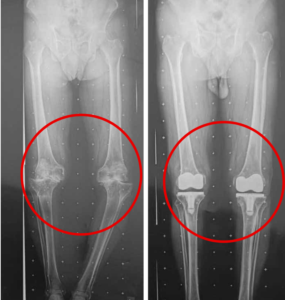
Total Knee Replacement: What You Need to Know
If you suffer from severe knee pain and disability due to arthritis or injury, you may have considered total knee replacement surgery. This is a common and effective procedure that can relieve your pain, improve your mobility, and restore your quality of life. But what exactly is total knee replacement and how does it work? In this article, we will answer some of the most frequently asked questions about this surgery and provide you with some tips on how to prepare for it and recover from it.
What is Total Knee Replacement ?
Total knee replacement, also known as total knee arthroplasty or total knee joint replacement, is a surgical procedure that involves removing the damaged parts of your knee joint and replacing them with artificial components made of metal and plastic. These components are designed to mimic the natural shape and function of your knee, allowing you to bend and straighten your leg smoothly and without pain.
The knee joint is formed by the lower end of the thighbone (femur), the upper end of the shinbone (tibia), and the kneecap (patella). These bones are covered with a smooth layer of cartilage that cushions them and enables them to glide easily. Between the femur and tibia, there are also two C-shaped pieces of cartilage called menisci that act as shock absorbers. The knee joint is surrounded by a thin membrane called the synovial membrane that produces a lubricating fluid. The knee joint is also supported by ligaments, tendons, and muscles that provide stability and strength.
When the cartilage or the menisci are damaged by arthritis or injury, they can cause friction, inflammation, and pain in the knee joint. This can make it difficult for you to perform everyday activities, such as walking, climbing stairs, or getting in and out of a chair. If nonsurgical treatments, such as medications, physical therapy, or injections, are no longer helpful, you may be a candidate for total knee replacement surgery.
How is Total Knee Replacement Performed?
otal knee replacement surgery is usually performed under general anesthesia, which means you will be asleep and not feel any pain during the operation. The surgery typically takes about one to two hours, depending on the extent of the damage and the complexity of the procedure.
The surgeon will make an incision in the front of your knee, exposing the knee joint. He or she will then remove the damaged cartilage and bone from the femur, tibia, and patella, and reshape the ends of these bones to fit the artificial components. The surgeon will then attach the metal components to the bones using special cement or screws. The metal components include a femoral component that covers the end of the femur, a tibial component that covers the top of the tibia, and a patellar component that covers the underside of the patella. The surgeon will also insert a plastic spacer between the femoral and tibial components to create a smooth surface for the joint to move. The surgeon will then close the incision with stitches or staples and cover it with a bandage.
What are the Benefits and Risks of Total Knee Replacement?
Total knee replacement surgery can provide significant benefits for people who have severe knee pain and disability that interfere with their daily life. Some of the benefits include:
- Reduced or eliminated pain
- Improved function and mobility
- Enhanced quality of life and well-being
- Increased ability to perform activities of daily living and hobbies
- Decreased dependence on medications or assistive devices
However, like any surgery, total knee replacement also carries some risks and potential complications. Some of the risks include:
- Infection of the wound or the joint
- Bleeding or hematoma
- Blood clots in the leg or lung
- Nerve or blood vessel injury
- Fracture of the bone
- Loosening or wear of the components
- Dislocation or instability of the joint
- Stiffness or limited range of motion
- Allergic reaction to the anesthesia or the materials
- Need for revision surgery
The risk of complications varies depending on your age, health, and other factors. Your surgeon will discuss the benefits and risks of the surgery with you and help you weigh your options. You should also ask your surgeon about his or her experience and success rate with this procedure.
How to Prepare for Total Knee Replacement Surgery?
Before you undergo total knee replacement surgery, you will need to undergo some tests and evaluations to make sure you are ready for the operation. These may include:
- Blood tests
- Urine tests
- Chest X-ray
- Electrocardiogram (EKG)
- Knee X-ray or MRI
- Physical examination
- Medical history review
- Medication review
- Anesthesia consultation
You will also need to prepare your home and yourself for the recovery period. Some of the things you can do are:
- Arrange for someone to drive you home and stay with you for the first few days after the surgery
- Stock up on groceries, medications, and other supplies
- Set up a comfortable and accessible sleeping area on the ground floor
- Remove any rugs, cords, or clutter that may cause you to trip or fall
- Install safety bars or handrails in your bathroom and shower
- Place a raised toilet seat or a commode chair in your bathroom
- Get a walker, crutches, or a cane to help you walk
- Get an ice pack or a cold therapy unit to reduce swelling and pain
- Get a compression device or stockings to prevent blood clots
- Follow your surgeon’s instructions on what to eat and drink and what medications to take or avoid before the surgery
- Stop smoking and drinking alcohol at least two weeks before the surgery
- Exercise regularly to strengthen your muscles and improve your circulation
How to Recover from Total Knee Replacement Surgery?
After the surgery, you will be taken to a recovery room where you will be monitored for any signs of complications. You will also receive pain medication and antibiotics to prevent infection. You will usually stay in the hospital for one to three days, depending on your condition and progress.
During your hospital stay, you will start physical therapy to help you regain your strength and range of motion. You will learn how to walk with a walker, crutches, or a cane, and how to perform some basic exercises to prevent stiffness and improve blood flow. You will also learn how to care for your wound and prevent infection.
You will be discharged from the hospital when you are able to:
- Get in and out of bed by yourself
- Walk with an assistive device for a short distance
- Bend and straighten your knee to a certain degree
- Manage your pain and swelling
- Perform your home exercises
You will need to continue your physical therapy at home or at an outpatient facility for several weeks or months. You will gradually increase your activity level and resume your normal daily activities as your knee heals and improves. You will also need to follow some precautions and guidelines to protect your new knee and prevent complications. These include:
- Keep your wound clean and dry and change your dressing as instructed
- Take your medications as prescribed and report any side effects
- Elevate and ice your knee several times a day to reduce swelling and pain
- Wear your compression device or stockings as instructed to prevent blood clots
- Avoid crossing your legs, twisting your knee, or kneeling
- Use your assistive device until your surgeon tells you to stop
- Avoid driving, lifting heavy objects, or engaging in strenuous activities until cleared by your surgeon
- Follow your surgeon’s recommendations on when and how to return to work, sports, or other activities
You will need to see your surgeon for regular follow-up visits to check your progress and healing. You will also need to have periodic X-rays to monitor the position and stability of your components. You can expect to have a full recovery and enjoy the benefits of your new knee within six to 12 months after the surgery.
Our Total Knee Replacement Patient Review
Frequently Asked Questions :
Yes, there are hundreds! We have helped design implants (such as the very successful Attune Knee System, from Johnson & Johnson) that are used worldwide. We decide the most suitable one based on a thorough assessment of patient age, weight, activity level, bone quality, deformity, and ligaments. Do let us know if you have a preferred design in mind and are allergic to nickel, chromium or cobalt.
uccess depends on the surgeon and his team's experience, skills and technique in performing it, and the implant design. Very few centres in India and around the world have performed Computer-assisted Total Knee Replacement for as many years and in as many patients as we have. We have treated over 20,000 patients who are very satisfied with their results which last for 10+ years in over 95%.
No! We have performed knee surgery in persons upto the age of 95 years provided they have undergone detailed examination, investigations, and assessment by our physicians.
We have successfully operated on patients even if they are overweight (upto 145 kg!), diabetic, and have heart problems - provided they have undergone a complete examination, investigations, and assessment by our physicians. Diabetes and high blood pressure need to be controlled before surgery. Usually after bypass surgery or stenting, we follow the cardiologist's recommendation and delay surgery for 6 months.
If there is also a spinal problem (slipped disc, sciatica, spondylosis, canal stenosis), this will need careful examination and investigations (like MRI scan, EMG). Knee surgery will get rid of knee pain but not cure spine-related pain, numbness, and tingling in the legs, which will require assessment by a neurologist/spinal surgeon. If spinal and knee pain are equally severe, we can help you decide which surgery should be done first. TKR can be done after spinal surgery.
Most patients can stand and take a few steps the same evening after surgery, and next day will be able to use a chair and commode, walk with a stick/walker, and climb a few steps. If there's an elevator, you can start going out of your house at 2 weeks. After a month, you can climb stairs, drive, swim, take long walks, and travel.
No! Most of our patients (over 90%) do not need physiotherapy. We will teach you 6 simple exercises which you can easily do yourself. Rarely, if your muscles are very weak, we may suggest a physiotherapist.
Most persons can drive 1 month after surgery.
Yes, you will be able to pick things up from the ground and reach low cupboards and drawers.
Walking, stationery cycling, swimming, yoga (preferably on a bed or sofa), doubles tennis and badminton, dancing, supervised weight training, and using a cross-trainer.
You will be shown how to climb a few steps the day after your surgery. We advise you to avoid climbing floors for 1month. Initially you may go up and down one foot at a time. Soon you will do stairs normally when your muscle strength and balance return.
Returning to normal varies from person to person depending on their condition before surgery usually taking 4-6 weeks and upto 6 months. Some stiffness, soreness and aching may last for 9-12 months.

